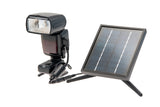Solar Adapter Cable
The Camtraptions Solar Adapter Cable allows you to create a simple and elegant flash system with game-changing solar recharging capabilities.
Using this cable and a Camtraptions Solar Panel, it is now possible to power your Camtraptions Flash and Wireless Flash Receiver for long periods of time using just a single set of four Ni-MH AA rechargeable batteries inside the flash. With adequate sunlight, this set-up can run indefinitely*.
The Solar Adapter Cable features 2-in-1 functionality:
- The cable allows you to reduce the number of batteries in your trap, by drawing a small amount of energy from the four batteries inside the flash to power the Wireless Flash Receiver. It is no longer necessary to use additional AAA batteries inside the Wireless Receiver.
- A Camtraptions Solar Panel can be plugged into the cable to recharge the flash’s four internal batteries during the daytime.
The Solar Adapter Cable is best-suited to environments with quite consistent sunlight. In areas where sunlight is more sporadic, it is better to connect the Solar Panel to an external 6V Ni-MH Flash Battery through a Flash Power Cable as the larger battery will provide a greater buffer if there are several overcast days in a row.
A 10m Solar Extension Cable can be placed between the Solar Panel and the Solar Adapter Cable to allow for more flexible placement of the panel relative to the flash, and to allow easier access to sunlight in shaded environments.
An alternative use for the Solar Adapter Cable is to power a Camtraptions Flash and its Receiver through the Waterproof Cable System, as demonstrated in this example setup.
Compatibility
- The Solar Adapter Cable can be used with Camtraptions Z Pro, Z2 and F1 Camera Trap Flashes, Camtraptions Wireless Receivers and Camtraptions Solar Panels.
- The Solar Adapter Cable cannot be used with other brands of flash or wireless flash triggers.
Specifications
- Weight: 54g
- Length: 220mm (approximate)
- Diameter of central section: 27.5mm
*limited only by the lifetime and number of charge cycles of the Ni-MH cells. When choosing Ni-MH rechargeable batteries for use with solar panels, we recommend selecting ones that are rated for a higher number of recharge cycles rather than those with the largest overall capacity.




